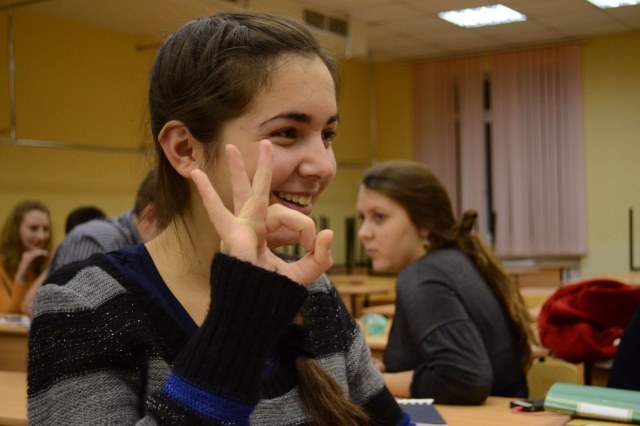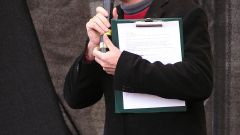With any disability, in the case involving compensatory mechanisms: the absence or weakness of one function kompensiruet at the expense of others. People with severe hearing impairments are communication, addressed to the vision. This use a "tool" that is always "in-itself".
Deaf people use two types of sign systems – manual alphabet and sign it.
Manual alphabet is a system of manual signs corresponding to the letters. Hand clenched, denotes the letter "a", the palm with straightened fingers clenched and set aside a large "b", etc. Such alphabets vary from language to language. In some countries (e.g. UK) dactylium two hands.
Russian manual alphabet involves dactyladenia one hand (often used right, but that principle does not matter). Arm is bent at the elbow, the hand is in front of the chest.
In sign language gestures do not represent individual letters or sounds, but entire words and concepts. There are sign languages that emerged in the communication of deaf people that are structurally different from verbal languages, and caliraya sign it, reproducing the structure of verbal. It's kind of "bridge" between sign language and the language of the listener.
Deaf typically use sign language as main, and manual – as a support, labeling it the names, titles, technical terms – in short, all that which no concepts-gestures.
Deaf people do not live in isolation from the "world of hearing", and to be integrated in this "world" of children before entering kindergarten.
Deafness is extremely rare total. In most cases, a person has residual hearing, which is open on certain frequencies and at very high volume. These people are heavy duty with a hearing aid. Full-fledged to hear this, but a certain percentage of auditory information, the person still receives. During class the child wear headphones with powerful sound enhancement.
Teachers of the deaf (teachers and educators working with deaf children) use all available "information channels" to "reach out" to the child's brain. Children early learn to read. In specialized kindergartens all actions are accompanied by a demonstration of signs with words and phrases. Appearing in kindergarten, the child must take the sign "Hello" and leaving "Bye," after eating "Thank you", etc. Demonstration of the plates combined with gestures, dactyladenia. Teaching the child the manual alphabet, the teacher teaches him to fold lips, respectively, the letters, puts his hand to the cheek, throat or nose, the child felt the vibration.
Thanks to these efforts, most children are able to develop to a certain extent even a sound. They say such people slurred their speech different in tone, but if you want you can understand them. Such people are able to read lips, which allows them to understand hearing. Communicating with deaf or hard of hearing person, can not turn away or cover your mouth.
Still, the communication of the deaf people with hearing remains difficult. In everyday life such people are usually using notes. In some cases, deaf people are helped by sign language interpreters. The need for their services arises when the deaf go to the doctor, give evidence to the police or in court, dealing with officials. Currently, there are even Orthodox churches, where worship services are held with the participation of the interpreter. Unfortunately, the number of sign language interpreters in the Russian Federation small: 1,000 deaf people, has only three sign language interpreters. The solution to this problem – in the future.
The deaf communicate with each other
Deaf people use two types of sign systems – manual alphabet and sign it.
Manual alphabet is a system of manual signs corresponding to the letters. Hand clenched, denotes the letter "a", the palm with straightened fingers clenched and set aside a large "b", etc. Such alphabets vary from language to language. In some countries (e.g. UK) dactylium two hands.
Russian manual alphabet involves dactyladenia one hand (often used right, but that principle does not matter). Arm is bent at the elbow, the hand is in front of the chest.
In sign language gestures do not represent individual letters or sounds, but entire words and concepts. There are sign languages that emerged in the communication of deaf people that are structurally different from verbal languages, and caliraya sign it, reproducing the structure of verbal. It's kind of "bridge" between sign language and the language of the listener.
Deaf typically use sign language as main, and manual – as a support, labeling it the names, titles, technical terms – in short, all that which no concepts-gestures.
Communication deaf hearing
Deaf people do not live in isolation from the "world of hearing", and to be integrated in this "world" of children before entering kindergarten.
Deafness is extremely rare total. In most cases, a person has residual hearing, which is open on certain frequencies and at very high volume. These people are heavy duty with a hearing aid. Full-fledged to hear this, but a certain percentage of auditory information, the person still receives. During class the child wear headphones with powerful sound enhancement.
Teachers of the deaf (teachers and educators working with deaf children) use all available "information channels" to "reach out" to the child's brain. Children early learn to read. In specialized kindergartens all actions are accompanied by a demonstration of signs with words and phrases. Appearing in kindergarten, the child must take the sign "Hello" and leaving "Bye," after eating "Thank you", etc. Demonstration of the plates combined with gestures, dactyladenia. Teaching the child the manual alphabet, the teacher teaches him to fold lips, respectively, the letters, puts his hand to the cheek, throat or nose, the child felt the vibration.
Thanks to these efforts, most children are able to develop to a certain extent even a sound. They say such people slurred their speech different in tone, but if you want you can understand them. Such people are able to read lips, which allows them to understand hearing. Communicating with deaf or hard of hearing person, can not turn away or cover your mouth.
Still, the communication of the deaf people with hearing remains difficult. In everyday life such people are usually using notes. In some cases, deaf people are helped by sign language interpreters. The need for their services arises when the deaf go to the doctor, give evidence to the police or in court, dealing with officials. Currently, there are even Orthodox churches, where worship services are held with the participation of the interpreter. Unfortunately, the number of sign language interpreters in the Russian Federation small: 1,000 deaf people, has only three sign language interpreters. The solution to this problem – in the future.

